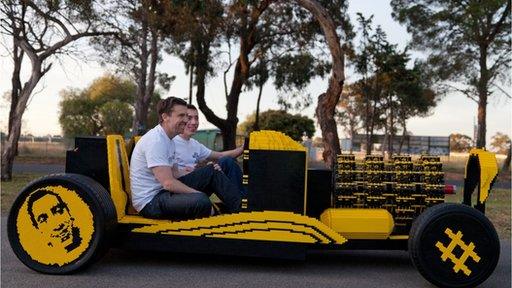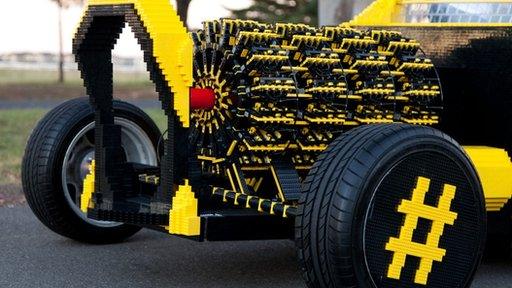Crowd-funded Lego car powered by air
- Published
A car made from Lego blocks and powered by compressed air
An air-powered car built of Lego, that can reach a top speed of around 20km/h (12mph) has hit the roads of Melbourne.
It was built by an Australian entrepreneur and a Romanian technologist who used more than 500,000 pieces of Lego to complete the car.
The crowd-funded project began with a tweet asking people to invest in an "awesome" start-up.
Four air-powered engines and 256 pistons, all built of Lego bricks, enable the car to move.
Everything bar the wheels is made from Lego.

The creators were worried about a large Lego explosion
Co-founder Steve Sammartino told the BBC that he was "neither a car enthusiast nor a Lego enthusiast".
"What I am is a technology enthusiast and I wanted to show what is possible when you crowd-fund an idea and use young talented people," he said.
"I met this crazy Romanian teenager on the web and we came up with the idea but I knew that I couldn't afford to fund it," he added.
So he sent out a late-night tweet which read: "Anyone interested in investing $500 - $1,000 in a project which is awesome and a world first tweet me. Need about 20 participants."

The engine is powered by air
Forty Australians offered cash and the Super Awesome Micro project, as it is dubbed, was born.
It took 18 months and a lot more money to build, said Mr Sammartino.
The car was constructed in Romania by him and his business partner Raul Oaida and then shipped to Australia where large parts of it needed to be rebuilt.
"We drove it in a suburb of Melbourne. The engine is fragile and the biggest fear was a giant Lego explosion impaling passers-by," Mr Sammartino told the BBC.
For the time being he has no plans on expanding the fleet.
"I've been up to my neck in Lego for four weeks and my fingers are still sore so I'm not keen on building another one just at the moment," he told the BBC.
"This can't have been an easy thing to make, let alone to make move. The engine in particular must have required some innovative thinking," said Matt Saunders, deputy road test editor of Autocar magazine.
"It doesn't look too comfortable though, and I wouldn't want to drive it very far. Or into anything by accident. Using Stickle Bricks in the crumple zones would have made for much better crash performance," he added.
- Published16 November 2013
- Published7 November 2013
- Published5 September 2013